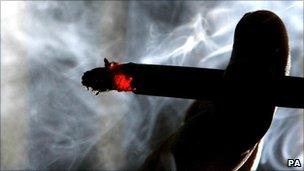Smoking: Is the glass half full or half empty?
- Published
- comments

Smoking rates are hovering just above 20%
It is easy to look at the produced on the performance of the NHS stop smoking service in its first decade of existence and conclude money has been wasted.
The unofficial target for the service in England is to get half of the people who turn to it for help to quit in the short-term - that is to say to give up for at least four weeks.
Over all the NHS failed to achieve this in any of the years from 2001 to 2011.
In fact, the data published on the British Medical Journal website shows if anything performance deteriorated slightly.
In the first year examined by the study 35% of those who used the service quit, compared to 34% in the most recent year.
But that would do the service an injustice.
In terms of providing value for money, stop smoking is among one of the most "cost-effective" treatments adopted by the NHS in the past decade, according to Martin Dockrell, of the Action on Smoking and Health campaign group.
Each short-term quitter costs the NHS just over Β£300 (I say NHS because even though smoking is now the responsibility of local government councils get a ring-fenced budget from health to pay for such schemes).
In terms of benefit to health, which is determined by a complex calculation known as quality adjusted life year, the health service would be prepared to pay five times as much.
Not only this, but the reach it has is impressive.
According to the figures for the year up to March 2011, the service made contact with about 8% of the nation's smokers.
New generation of smokers
Of course, only a minority end up quitting in the long term.
About 80% of those who give up for four weeks will relapse at some point.
But, nonetheless, the service is helping make inroads into what was considered only a few years ago to be a hardcore group of smokers which were pretty resistant to stop smoking advice.
Since the mid 1990s the numbers of smokers have been hovering stubbornly above the 20% mark.
However, there are signs that is beginning to fall, albeit slowly.
In recent years the numbers have come down by less than 1% a year.
Some of that is down to smokers dying and the success of health campaigns in discouraging a new generation of smokers from taking up the habit.
But some of it is undoubtedly linked to the success of the NHS stop smoking service - and that is why experts are hailing it as the "jewel in the NHS crown".